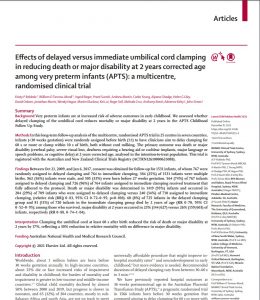
Background
Very preterm infants are at increased risk of adverse outcomes in early childhood. We assessed whether delayed clamping of the umbilical cord reduces mortality or major disability at 2 years in the APTS Childhood Follow Up Study.
Methods
In this long-term follow-up analysis of the multicentre, randomised APTS trial in 25 centres in seven countries, infants (<30 weeks gestation) were randomly assigned before birth (1:1) to have clinicians aim to delay clamping for 60 s or more or clamp within 10 s of birth, both without cord milking. The primary outcome was death or major disability (cerebral palsy, severe visual loss, deafness requiring a hearing aid or cochlear implants, major language or speech problems, or cognitive delay) at 2 years corrected age, analysed in the intention-to-treat population. This trial is registered with the Australian and New Zealand Clinical Trials Registry (ACTRN12610000633088).
Findings
Between Oct 21, 2009, and Jan 6, 2017, consent was obtained for follow-up for 1531 infants, of whom 767 were randomly assigned to delayed clamping and 764 to immediate clamping. 384 (25%) of 1531 infants were multiple births, 862 (56%) infants were male, and 505 (33%) were born before 27 weeks gestation. 564 (74%) of 767 infants assigned to delayed clamping and 726 (96%) of 764 infants assigned to immediate clamping received treatment that fully adhered to the protocol. Death or major disability was determined in 1419 (93%) infants and occurred in 204 (29%) of 709 infants who were assigned to delayed clamping versus 240 (34%) of 710 assigned to immediate clamping, (relative risk [RR]) 0·83, 95% CI 0·72–0·95; p=0·010). 60 (8%) of 725 infants in the delayed clamping group and 81 (11%) of 720 infants in the immediate clamping group died by 2 years of age (RR 0·70, 95% CI 0·52–0·95); among those who survived, major disability at 2 years occurred in 23% (144/627) versus 26% (159/603) of infants, respectively (RR 0·88, 0·74–1·04).
Interpretation
Clamping the umbilical cord at least 60 s after birth reduced the risk of death or major disability at 2 years by 17%, reflecting a 30% reduction in relative mortality with no difference in major disability.